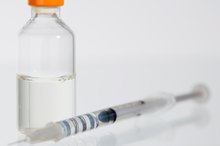Gynecomastia is a condition characterized by abnormal breast growth in males. The condition is most common in newborn babies, boys reaching puberty and older men. At these times, male bodies are undergoing shifts in hormone levels that can result in the development of feminine traits, such as breast growth. Gynecomastia is technically defined as the growth of actual breast tissue, which is different from the growth of fat tissue that may occur in the breast area of obese men. Although the hormonal imbalances that cause gynecomastia may occur naturally, in approximately 10 to 20 percent of cases, gynecomastia is triggered by certain illegal or prescription drugs, explains the University of Texas Health Science Center 3.
Chemotherapy Agents and AIDS Medications
During chemotherapy, many harsh, toxic chemicals are used to kill cancer cells. These drugs may also imbalance the levels of sex hormones in the body, which can cause abnormal breast growth in men. Additionally, the mixtures of drugs used to treat AIDS, known as highly active antiretroviral therapy, may cause gynecomastia, the Mayo Clinic.com explains 1. Combinations including the anti-retroviral drug efavirenz are the most likely to increase the growth of breast tissue.
- During chemotherapy, many harsh, toxic chemicals are used to kill cancer cells.
- Additionally, the mixtures of drugs used to treat AIDS, known as highly active antiretroviral therapy, may cause gynecomastia, the Mayo Clinic.com explains 1.
Antipsychotic, Antidepressant and Anti-anxiety Drugs
Side Effects of Dianabol
Learn More
Several antipsychotic medications, including haloperidol, phenytoin and phenothiazines have been linked to gynecomastia. Tricyclic antidepressant medications, which are older antidepressants that are only infrequently prescribed now that selective serotonin reuptake inhibitors are available, also increase the risk of gynecomastia. Diazepam, which is usually sold under the brand name Valium, and other anti-anxiety drugs may also induce the growth of breast tissue.
Anti-Androgen Drugs
These anti-androgen drugs are often prescribed to treat prostate enlargement or prostate cancer, and have the unfortunate side effect of disrupting balance of sex hormones. This disruption of sex hormones can lead to the development of female secondary sex characteristics like breast growth, according to the Drexel University College of Medicine.
Heart and Blood Pressure Medications
What Are the Dangers of Finasteride With Testosterone?
Learn More
Several drugs prescribed to treat high blood pressure and heart conditions carry the risk of increased breast tissue growth. ACE inhibitor drugs, such as lisinopril, ramparil and enalapril, treat high blood pressure and congestive heart failure. These drugs may disrupt sex hormones and cause gynecomastia. Calcium channel blocking drugs, such as verapamil, are another type of heart medication that carry a high risk of abnormal breast enlargement in men. Digitalis, also called digoxin, and amiodarone are other common heart medications that have been linked to gynecomastia.
- Several drugs prescribed to treat high blood pressure and heart conditions carry the risk of increased breast tissue growth.
- Digitalis, also called digoxin, and amiodarone are other common heart medications that have been linked to gynecomastia.
Other Medications
Some drugs that reduce stomach acid and are used to treat stomach ulcers, such as cimetidine and omeprazole, may induce breast growth in men. Metronidazole, an antibiotic medication commonly used to treat bacterial infections, may increase the risk of gynecomastia, as does isoniazid, an antibiotic used to treat tuberculosis.
Steroids, Alchohol and Illegal Drugs.
Anabolic steroids are sometime abused because of their effect on enhancing athletic performance. These drugs are very similar to the male sex hormones, however they can disrupt the balance of sex hormone and induce female secondary sex characteristics, including breast growth, according to the National Institute on Drug Abuse 2. Alcohol and illegal drugs such as heroin, amphetamines and marijuana have also been linked to male breast growth, particularly in adult males.
Related Articles
References
- Mayo Clinic.com: Gynecomastia (Enlarged Breasts in Men)
- National Institute on Drug Abuse: Anabolic Steroids
- University of Texas Health Science Center at Houston: Male Breasts - Gynecomastia: When Nature Gets Confused
- Cuhaci, Neslihan. Gynecomastia: Clinical evaluation and management. Indian J Endocrinol Metab. 2014 Mar-Apr 18(2): 150-158. https://dx.doi.org/10.4103/2230-8210.129104
- Cuhaci N, Polat SB, Evranos B, Ersoy R, Cakir B. Gynecomastia: Clinical evaluation and management. Indian J Endocrinol Metab. 2014;18(2):150-8. doi:10.4103/2230-8210.129104
- Lemaine V, Cayci C, Simmons PS, Petty P. Gynecomastia in adolescent males. Semin Plast Surg. 2013;27(1):56-61. doi:10.1055/s-0033-1347166
- Niewoehner CB, Schorer AE. Gynaecomastia and breast cancer in men. BMJ. 2008;336(7646):709-13. doi:10.1136/bmj.39511.493391.BE
- Male Breast Cancer. MedlinePlus. Jul 11, 2019.
- Dickson G. Gynecomastia. American Family Physician. Apr 1, 2012.
- Henley DV, Lipson N, Korach KS, Bloch CA. Prepubertal gynecomastia linked to lavender and tea tree oils. N Engl J Med. 2007;356(5):479-85. doi:10.1056/NEJMoa064725
- 2016 Cosmetic Surgery National Data Bank Statistics. The American Society for Aesthetic Plastic Surgery.
- Taheri AR, Farahvash MR, Fathi HR, Ghanbarzadeh K, Faridniya B. The Satisfaction Rate among Patients and Surgeons after Periareolar Surgical Approach to Gynecomastia along with Liposuction. World J Plast Surg. 2016;5(3):287-292.
- Cuhaci, Neslihan. Gynecomastia: Clinical evaluation and management. Indian J Endocrinol Metab. 2014 Mar-Apr 18(2): 150-158.
- Henley DV, et al. Prepubertal gynecomastia linked to lavender and tea tree oils. N Engl J Med. 2007 Feb 1;356(5):479-85. doi:10.1056/NEJMoa064725
- Johnson Ruth E and Murad M Hassan. Gynecomastia: Pathophysiology, Evaluation, and Management. Mayo Clin Proc. 2009 Nov; 84(11): 1010–1015. doi:10.1016/S0025-6196%2811%2960671-X
- Love Susan. "Dr. Susan Love's Breast Book." Sixth edition. Hachette Book Group; 2015.
- Niewoehner CB, Nuttal FQ. Gynecomastia in a hospitalized male population. Am J Med. 1984 Oct; 77(4):633-8. doi:10.1016/0002-9343(84)90353-x
- Taheri Ahmad Reza. The Satisfaction Rate among Patients and Surgeons after Periareolar Surgical Approach to Gynecomastia along with Liposuction. World J Plast Surg. 2016 Sep; 5(3): 287–292.
- Toorians AW, et al. Gynaecomastia linked to the intake of a herbal supplement fortified with diethylstilbestrol. Food Addit Contam Part A Chem Anal Control Expo Risk Assess. 2010 Jul;27(7):917-25. doi:10.1080/19440041003660869
Writer Bio
Matthew Busse has pursued professional health and science writing since 2007, writing for national publications including "Science Magazine," "New Scientist" and "The Scientist." Busse holds a doctorate in molecular biology from the University of California-San Diego.









